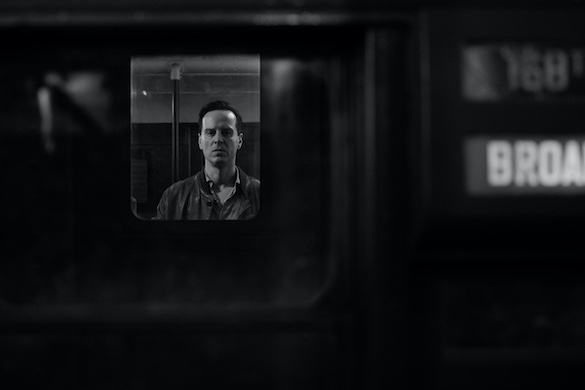‘The Talented Mr. Ripley’ Gets a Stark Makeover in New Netflix Series
The story of ‘Ripley’ hews closely to Patricia Highsmith’s sturdy plot, but writer/director Steven Zaillian, author of the Oscar-winning screenplay for ‘Schindler’s List,’ also makes a few curious changes.

The best thing so far about the new Netflix series “Ripley” is its black-and-white cinematography. The latest adaptation of Patricia Highsmith’s “The Talented Mr. Ripley,” the handsome show features silvery, occasionally high-contrast, monochrome photography by an Oscar winner, Robert Elswit (“There Will Be Blood”), that creates a stark, noirish mood — in keeping with the story of a devious, murderous man.
Right from the start, its quick, static shots of metal railings, stairwells, fire escapes, and more combine with key lighting and shadows to generate both a “vintage” look of the early 1960s and a sort of dazzling dread. Even when the narrative shifts to Italy and viewers are denied the escapist pleasure of sensual color, the imagery thrills with glaring white passageways, inky black nights, and ominous gray skies.
Having viewed two episodes of the eight-episode season, I can affirm that the story hues closely to the book’s sturdy plot, which will be familiar to anyone who’s seen 1999’s “The Talented Mr. Ripley,” starring Matt Damon, or the 1960 French film “Purple Noon,” featuring Alain Delon. New York grifter Tom Ripley is recruited by a Mr. and Mrs. Greenleaf to bring their son Dickie, a remote acquaintance of Tom’s, back to the U.S. from what they consider a life of dissipation in Italy.
Desperate for a different life and enticed by the Greenleafs’ wealth, Ripley accepts the mission and soon finds himself at a small Italian town near Naples. As he steadily gains Dickie’s confidence, and inspires suspicion in Dickie’s sometime girlfriend Marge, Ripley starts to covet his friend’s lifestyle. And so begins his maneuvers to become Dickie.

Writer/director Steven Zaillian, author of the Oscar-winning screenplay for “Schindler’s List” as well as other acclaimed scripts, makes a few changes in these early episodes, such as mentioning the mafia in one scene, thereby tying the story to later Ripley novels by Highsmith and anticipating potential additional seasons.
Perhaps his biggest alteration, though, is to have Ripley and Dickie portrayed by actors who aren’t in their 20s or even early 30s. This presents a few problems, one of which is the idea that a parent would attempt to retrieve a mildly wayward son when he’s already well into adulthood. Another issue with the casting is that the actors, by virtue of their middle age, are too laid-back in temperament, and so their conversations come off awkwardly, listlessly. Their friendship lacks chummy momentum, and viewers may question why Dickie hangs out with Tom at all beyond their tenuous association in New York.
The British actor Andrew Scott, in the ascendant due to acclaimed roles in last year’s “All of Us Strangers” and the comedy series “Fleabag,” seems like the right choice to play Ripley, despite being nearly double the character’s age in Highsmith’s novel. The actor’s ambiguous expressions align at times with the character’s mysterious motives. And his paradoxically intense and blank stares are only magnified by the black-and-white photography, turning his dark eyes into black holes of need and emptiness.
At one point in her novel, Highsmith writes that the eyes “are the one place you could look at another human being and see what really went on inside, and in Dickie’s eyes Tom saw nothing ….” Although she’s describing a thought of Tom’s as he’s looking at Dickie, the passage could easily describe Mr. Scott’s gaze.
As good as he is as Ripley, Mr. Scott, though, can’t make the character’s skill with book editing make sense. Mr. Zaillian has Tom ingratiate himself with Marge by having the character improve her manuscript (another change from the novel), but nothing we witness in Ripley squares with this prowess. The character is predominantly depicted as a nebbish — dull, slow-witted, and uncultured — with little or no talent at anything beyond minor scams. And yet in the second episode, he’s suddenly a latter-day Ruskin. Are Mr. Scott and Mr. Zaillian establishing Ripley as smarter than he lets on? We’ll have to keep watching to know for sure.

